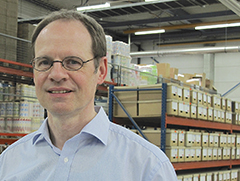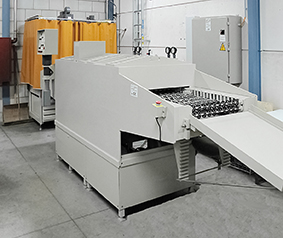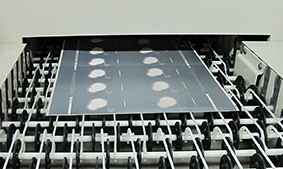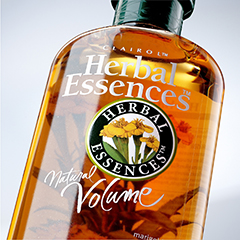Skanem Willich Finds Screen Printing Indispensable
- Published: March 05, 2014
WILLICH, GERMANY | Skanem Willich GmbH is part of the Skanem Group, which was founded in Norway in 1905 and is now the largest European print shop group for self-adhesive labels. The company in Germany uses state-of-the-art narrow-web, roll-fed presses equipped with flexographic printing units and embossing and screen printing finishing options to produce high quality labels for body care, household, car maintenance, and other care products. Skanem Willich GmbH knows how to harness the added value from screen printing and has cut costs by bringing standardized and automated screen manufacturing in-house.
 Skanem Willich GmbH decided to switch from letterpress to flexographic presses with the screen printing and embossing options in 1999 as part of a drive to increase production efficiency, since flexographic printing enabled the company to print highly attractive labels faster and at lower cost. This decision was embraced by Skanem’s customers and production was thus subsequently focused almost exclusively on flexographic printing.
Skanem Willich GmbH decided to switch from letterpress to flexographic presses with the screen printing and embossing options in 1999 as part of a drive to increase production efficiency, since flexographic printing enabled the company to print highly attractive labels faster and at lower cost. This decision was embraced by Skanem’s customers and production was thus subsequently focused almost exclusively on flexographic printing.
Yet whenever high coverage, precise detail and color intensity are needed, screen printing is more suitable than flexographic printing. This printing process had long been extremely costly for Skanem Willich due to the need to have screens manufactured by external service providers and was only used at the express request of customers. However, Skanem wanted to get away from the escalating interchangeability of label printers and be able to offer its customers higher quality labels to give them a competitive edge. A more cost effective solution for screen manufacture thus had to be found and, after considerable deliberation, Skanem opted for in-house screen production.
 In 2009, Gallus Ferd. Ru?esch AG supplied the necessary equipment to manufacture Gallus Screeny screen printing cylinders using Gallus Screeny materials and ensured that Skanem Willich GmbH could also use Gallus Screeny screen printing plates on non-Gallus machines. Yet at that time screen manufacture still took over half an hour, manual washing out and the lengthy drying process often produced unsatisfactory results, and the follow-up costs, if the processes were not carried out exactly, were extremely high.
In 2009, Gallus Ferd. Ru?esch AG supplied the necessary equipment to manufacture Gallus Screeny screen printing cylinders using Gallus Screeny materials and ensured that Skanem Willich GmbH could also use Gallus Screeny screen printing plates on non-Gallus machines. Yet at that time screen manufacture still took over half an hour, manual washing out and the lengthy drying process often produced unsatisfactory results, and the follow-up costs, if the processes were not carried out exactly, were extremely high.
However, the Gallus wash-out machine, which was launched three years ago, solved these problems almost entirely and also reduced the employee skills required for manufacturing screen printing plates. It rinses Gallus Screeny screen printing plates perfectly in a single pass and sends them dried to the delivery after just four to five minutes.
 The integrated solution from Gallus enables Skanem Willich to manufacture Gallus Screeny screen printing plates in an industrial, automated, and standardized process in line with that used for its flexographic printing plates and led to improved product quality and significant cost reductions. The ease of manufacturing a Gallus Screeny screen printing plate convinced even the most skeptical employees. The length of exposure in the contact frame and the correct settings for the required washing out times, depending on the specific screen printing plate, can be easily read from a table.
The integrated solution from Gallus enables Skanem Willich to manufacture Gallus Screeny screen printing plates in an industrial, automated, and standardized process in line with that used for its flexographic printing plates and led to improved product quality and significant cost reductions. The ease of manufacturing a Gallus Screeny screen printing plate convinced even the most skeptical employees. The length of exposure in the contact frame and the correct settings for the required washing out times, depending on the specific screen printing plate, can be easily read from a table.
Prepress staff have been trained to produce both screen printing and flexographic printing plates. If a screen printing cylinder needs to be replaced at three o'clock in the morning, a new one can be produced in less than half an hour. No printer would manage to changeover a ten-color press in this short time. Gallus Screeny screen printing plates are therefore now produced, printed, and stored in-house at Skanem Willich. The reusage concept developed by Gallus enables screens to be archived and reused for reprints.
 Skanem Willich GmbH is now once again using screen printing for over 25% of all labels, particularly for transparent self-adhesive labels. Only with this printing process is it possible, for example, to underlay a motif with white that is as opaque as possible with four to eight grams of ink per square meter or to produce a very small wordmark that is sharp, rich in contrast, and clearly legible.
Skanem Willich GmbH is now once again using screen printing for over 25% of all labels, particularly for transparent self-adhesive labels. Only with this printing process is it possible, for example, to underlay a motif with white that is as opaque as possible with four to eight grams of ink per square meter or to produce a very small wordmark that is sharp, rich in contrast, and clearly legible.
While many of Skanem Willich’s competitors are on a seemingly unavoidable downward spiral in the price war, much of their product quality is falling by the wayside. Skanem Willich, on the other hand, can supply its customers with labels that pass the “first moment of truth” test on a supermarket shelf with flying colors and thus offer probably the most convincing arguments for investing in screen printing—standing out from the crowd and premium quality. These are the crucial factors for every label producer to enjoy long-term success on an ever fiercer market.




